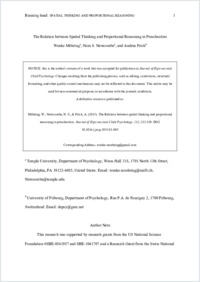The relation between spatial thinking and proportional reasoning in preschoolers
- Möhring, Wenke University of Basel
- Newcombe, Nora S. Temple University
- Frick, Andrea University of Fribourg
-
20.02.2015
Published in:
- Journal of Experimental Child Psychology. - 2015, vol. 132, p. 213–220
English
Previous research has indicated a close link between spatial and mathematical thinking. However, what shared processes account for this link? In this study, we focused on the spatial skill of map reading and the mathematical skill of proportional reasoning and investigated whether scaling, or the ability to relate information in different-sized representations, is a shared process. Scaling was experimentally manipulated in both tasks. In the map task, 4- and 5-year-olds (N = 50) were asked to point to the same position shown on a map in a larger referent space on a touch screen. The sizes of the maps were varied systematically, such that some trials required scaling and some did not (i.e., the map had the same size as the referent space). In the proportional reasoning task, children were presented with different relative amounts of juice and water and were asked to estimate each mixture on a rating scale. Again, some trials required scaling, but others could be solved by directly mapping the proportional components onto the rating scale. Children’s absolute errors in locating targets in the map task were closely related to their performance in the proportional reasoning task even after controlling for age and verbal intelligence. Crucially, this was only true for trials that required scaling, whereas performance on nonscaled trials was not related. These results shed light on the mechanisms involved in the close connection between spatial and mathematical thinking early in life.
- Faculty
- Faculté des lettres et des sciences humaines
- Department
- Département de Psychologie
- Language
-
- English
- Classification
- Psychology
- License
-
License undefined
- Identifiers
-
- RERO DOC 324087
- DOI 10.1016/j.jecp.2015.01.005
- Persistent URL
- https://folia.unifr.ch/unifr/documents/307457
Statistics
Document views: 117
File downloads:
- Texte intégral: 389
